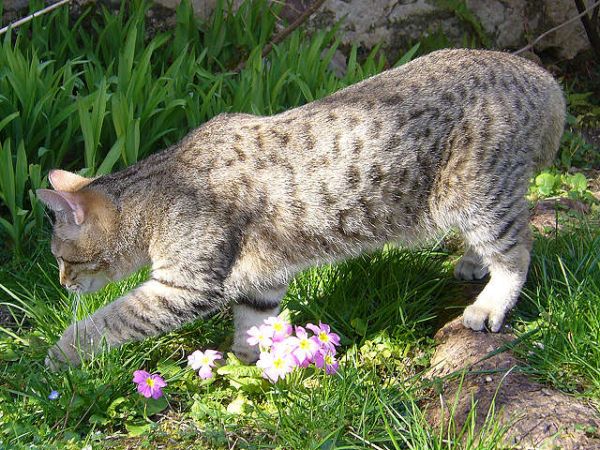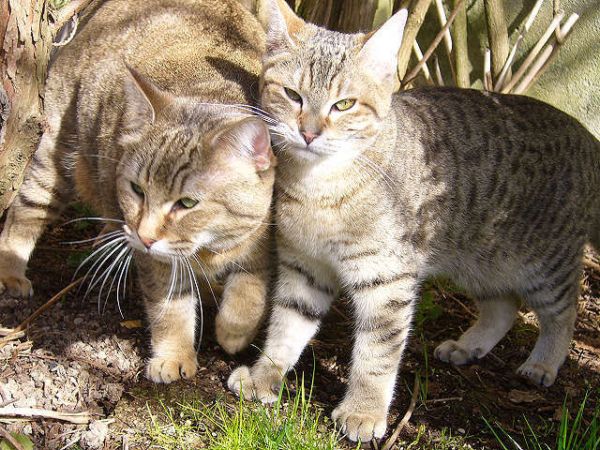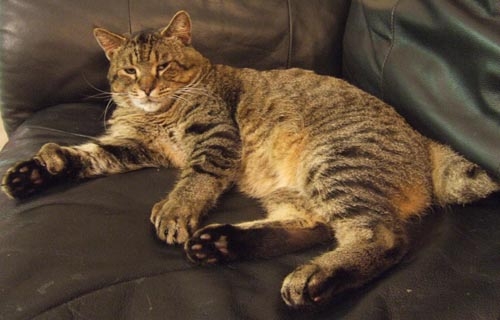The Pixiebob Cat Breed
History
The Pixiebob cat breed originated in the Northwestern United States. In 1985 Carol Ann Brewer bought a polydactyl spotted male kitten with a short tail from a couple in Washington State. In January 1986, Carol Ann rescued a classic patterned male cat. This cat had a short tail and stood as tall as her knees.
Carol Ann named this cat Keba. In April 1986, Keba and a domestic female cat had a litter of kittens. One of these kittens had muted spotting on a reddish-fawn coat and quite a wild look about her. Carol Ann named this kitten Pixie.
 Spotted tabby Pixiebob cat - Natalie Bent
Spotted tabby Pixiebob cat - Natalie Bent
Carol Ann soon realized that these short-tailed cats had a distinctive look and she started to search for more cats with this look. She also decided to create more cats that looked like Pixie in order to preserve her uniqueness.
In 1989 she documented the distinctive traits of this new cat breed and decided to call it Pixiebob. Carol Ann applied to TICA in 1993 to begin the recognition for the Pixiebob cat breed and in 1994 TICA accepted this cat breed for Exhibition Status. In May 1996 it had advanced to New Breed Status and in 1997 the Pixiebob was granted championship status.
Description
The Pixiebob cat is a medium to large cat breed with a muscular body and substantial boning. The hind legs are slightly longer than the front legs. The paws are big and have long thick toes.
Mature males weigh between 12-17 pounds and mature females weigh between 8-12 pounds. The face of the Pixiebob cat breed has a look similar to the wild bobcat with a heavy brow and triangular eyes. The eyes are golden brown or gooseberry green.
The tail of the Pixiebob is often knotted or kinked but it should be able to move naturally and be flexible. The minimum tail length is 2 inches but there are Pixiebob cats that will have shorter or longer tails.
 Short-haired Pixiebob kittens - Natalie Bent
Short-haired Pixiebob kittens - Natalie Bent
The Pixiebob cat breed has two coat varieties – longhair and shorthair. The coat has a woolly texture and is double thick, standing up from the cat’s body which gives it a cushioned feel.
Longhair Pixiebob cats have a soft, silky coat that can be up to 2 inches in length. Some cats have the lynx tips on their ears and look like the wild bobcat that they were bred to resemble. The facial hair grows downward and it can sometimes look like the cat has sideburns.
Grooming is easy with both the short haired and the long haired Pixiebob. A weekly brushing is enough to remove loose hair and keep the coat in perfect condition.
The ideal coat color is a brown spotted tabby that can range from tawny to reddish brown shades. The spots are small and muted by heavy ticking. In the winter the ticking may be darker and also silver-toned.
The Pixiebob cat breed is the only cat breed that is allowed to have polydactyly with the maximum number of toes being seven. Cats normally have 5 toes on the front paws and 4 on the back paws. Polydactyl cats have more toes and can have more on one foot than on the others. The extra toes usually tend to appear on the front feet more than on the back feet.
 Polydactyl 6 year old male Pixiebob cat (note also the short tail) - Kyle Fuller
Polydactyl 6 year old male Pixiebob cat (note also the short tail) - Kyle Fuller
Personality & Temperament
The Pixiebob cat breed is an active and social cat that is good with children and other pets.
Often described to be almost “doglike” in its loyalty, this cat breed will bond strongly with the family that it adopts. This is a type of cat that you can train to walk on a leash and harness and they love to play games of fetch.
The Pixiebob is a very easy-going cat breed that likes to communicate with you in a series of chirps and soft meows. You might occasionally even get a growl – but do not fear – this is merely another way this unique looking cat communicates with you.







